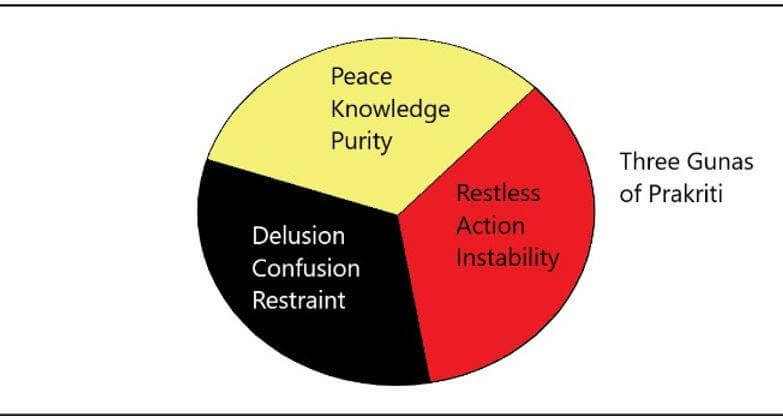Author: Randeep Singh / go to all Samkhya Karikas

Samkhya Karika 12 text:
Preeti-apreeti-vishaada-atmakaah prakaasha-pravirtti-niyama arthaah ||
Anyonya abhibhava ashraya janana mithuna vrittayaah cha gunah ||
Preeti – affection, purity, respect
Apreeti – hate, dislike
Vishaada – confusion, delusion
Atmakaah – nature of
Prakaasha – light, illumination
Pravirtti – actions
Niyama – discipline, restraint
Arthaah – reason behind, purpose
Anonya – together, mutually
Abhibhava – dominating, controlling
Ashraya – supportive
Janana – creative, productive factor
Mithuna – conjoin, cooperate
Vrittayaah – modifications, changes
Ca – and
Gunah – of gunas, the attributes of Prakriti
The nature of each of the three gunas which form the Prakriti is described in this Samkhya karika 12 without attributing any names (sattva, rajas, tamas) to them. A general description of the three types of characteristics which make up the Prakriti is given here.
Individual nature of three Gunas of Prakriti | Samkhya Karika 12
The first attribute of one of the characteristics is described as preeti. The term preeti carries a number of meaning to itself; affection, love, grace, happiness, peace, respect, kindness, purity, and knowledge. The aim of preeti is described as illumination, or enlightenment which helps dissipate darkness. The opposite traits of this characteristic would be blindness, lack of intelligence, absence of knowledge, and haphazardness. The whole bunch of these attributes has been called as Sattva guna in the later karikas.
The second attribute of another characteristic of the essence of Prakriti is apreeti. Letter “a” placed before any word is meant to be reversing its meaning as per the rules of Sanskrit language, but here it doesn’t stand as the opposite of preeti, in fact it means the movement which arises as the gunas move, mix into each other. It is the interplay of the opposing qualities of what preeti stands for.
The essence of this characteristic is action or pravirtti. This characteristic is named as rajas in the coming karikas and it represents the restless instability created by the movement, action due to the emergence of opposite forces like love-hate, likes-dislikes. It is the propensity to put the knowledge of sattva at work. For evolution to take place the status quo (stability) of sattva needs to be shaken and some action needs to take place, rajas does exactly the same.
The main attribute of the third characteristic, described as tamas in later karikas, is vishaada, which means delusion and confusion. The main objective of tamas is niyama, or discipline. The discipline here means which stops motion, action. It brings stability and grounding to the combination of the other two characteristics, sattva and rajas taken together. Tamas is more about restraining as without it other two would beget an uncontrollable flurry of actions, activities. It is more about inaction, sloth and attachment that fixates the entity in question. Tamas is supposed to be dominant as one sleeps, as both sattva (knowledge), and rajas (action) are put to rest here.
Nature of Three Gunas taken together
The three gunas do not exist as separate entities within the prakriti, but they exist as three interwoven strands of a rope. One of the meanings of the term guna is strand of a rope that binds. A myriads of meanings have been attributed to the term guna; some interpret it as quality, others look at it as characteristics, category, substance or constituents.
By some, gunas have been described as the psychological manifestation of enlightened mind (sattva) active mind (rajas) and a stupefied mind (tamas). Samkhya sees it as quality, and some describe them as the mesh formed by the interweaving of the three which serves the purpose of being the substratum of the universe which keeps the Purusha shackled to the world.
The evolution, or the world is created from the three gunas as they work in relation to each other and support each other in it. All the changes or transformation that occurs within prakriti, the world and the human temperament are all the result of the inextricable intermixing of the three gunas in various proportions. The gunas are in an incessant flux of change all the time, and one of the three remains predominant over the other two at any given moment.
Suppose sattva is dominant at a given moment, rajas and tamas will remain non-prominent, both providing the required activity, and restraint (stability) to the entity so formed. This states that existence of anything is in a constant state of change. The mental and intellectual states remain fluid due to the constant flow of thoughts caused by rajas. Some fraction of stability in the thoughts – tamas – and illumination – sattva – is also present along side it in order to complete the existence of the entity of a thinking mind.
The concept of gunas is true to the elementary and atomic levels of one’s existence. The aim of Samkhya is to make us understand that this interplay of gunas keeps the real self – Purusha – bound (and hidden) to the material world, the conscious self, or the Purusha becomes liberated only when one is able to arrest the unhindered circus. Gunas form the basis of everything, living and non-living, manifest and unmanifest. Their nature is different but they work towards a common goal.
Samkhya philosophy shows us the svaroop (form) of nature. In real life too we meet persons of different temperaments – dull, sharp, active – depending on the guna which is dominant at that particular moment. The purpose of Samkhya is to teach us that we need to inculcate sattva guna within ourselves and maintain it under any circumstances. Ones we understand the essence of this karika in depth we would know how to maintain a balance in everything exciting (rajas), or not very interesting ( tamas) that tends to pull us into its grip.
